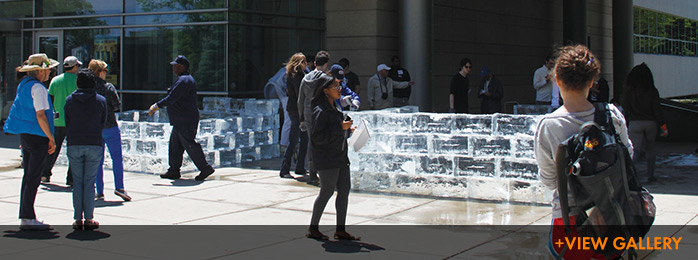Art on Ice
The directions for the artwork were simple: “Using ice blocks, build two cubic structures that measure 10 feet long, 10 feet wide, and 8 feet high. Their walls are unbroken. They are left to melt.”
And melt they did. Rivulets ran down the walls’ glassy sides, even while more than 50 soggy Northwestern students, faculty, staff, and passersby were still placing 360 ice blocks one on top of another. The structures began to crumble in the bright May sunshine within a few hours of their completion, and by the next morning not many chunks of ice remained amidst the puddles in front of the Mary and Leigh Block Museum of Art.
No matter, because the goal of Fluids, as this Conceptual piece is titled, was not permanence but rather bringing people together to share an experience. The project grew out of art theory and practice professor Iñigo Manglano-Ovalle’s Alternative to the Object class that explores Conceptual art and its resistance to commodification. The nine students in the innovative class reinvented Fluids, which was originally conceived by the artist Allan Kaprow in 1967. Kaprow believed that art belonged in the fabric of everyday life and should remain free from the constraints of museums. He is regarded as the father of Happenings—art events that are closely tied to performance art, in which artists join viewers in an activity.
Fluids gave students the opportunity to bring alive an art form rooted in the 1960s and ’70s avant-garde. “We study and practice art as life, art as experience, art as gesture,” explains Manglano-Ovalle, a MacArthur Fellow in 2001 who recently joined Weinberg College. “The audience is not there, because the audience is the maker. The audience is dead.”
Kaprow would have been pleased at their efforts. Dozens of people in waterproof gloves and ponchos scraped, hauled, and positioned heavy ice blocks, while curious onlookers chatted and ate snow cones made by Andrew Paulson ’13, a student in Manglano-Ovalle’s class. Campus hierarchy dissolved as students instructed professors where to place the blocks on the structures.
Despite its impermanence, Manglano-Ovalle asserts that Fluids has stood the test of time as a work of art. “Think of the materials involved. Water. Ice. Weather. These things mean something very different today than in the 1960s. But there’s still a sense of radicalism and subversion with a heavy dose of optimism.”
When Manglano-Ovalle approached Lisa Corrin, the Block’s new director, about collaborating on a reinvention of Kaprow’s original Happening, she said I didn’t have to think for a second. Talk about experiential education! The students are learning about what a Happening is, learning about an artist who questioned what art should be, what materials should be. This work questions what the Block is, because you couldn’t show it in a museum.”
Building Fluids was especially satisfying for Clare Roth ’14, a student in the class, who says she will never forget the experience. “We’re not creating something that will last but something that will live on in our minds.”
And the success of Fluids may signal a new crop of Happenings on campus. “This disappears,” Manglano-Ovalle said with a wry smile, gesturing toward the gleaming structures. “Then you have to do something else.”
Read more about Professor Manglano-Ovalle.
Back to top